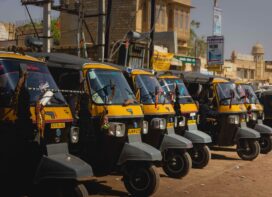
There is increasing discussion around the importance of incorporating a gender lens in urban mobility, with limited attention to urban governance and planning frameworks. Currently, it is being undertaken through Gender Specialists and Gender Action Plans or Gender Equality and Social Inclusion Action Plan  on a project or programme basis, often through bilateral and multilateral investments, writes Sonal Shah, Founder of the Urban Catalysts and the Executive Director for the Centre for Sustainable and Equitable Cities.
on a project or programme basis, often through bilateral and multilateral investments, writes Sonal Shah, Founder of the Urban Catalysts and the Executive Director for the Centre for Sustainable and Equitable Cities.
Create a policy framework that focuses on women, girls, gender minorities in cities
A holistic policy framework for the next 10 years is required to take stock of the status of women, girls, gender minorities in cities and address gender inequities. This could be led by the women and child welfare department in municipal government in partnership with the urban development authority, metropolitan transport authority (where it is effectively functioning), and a collaborative process involving a wide range of non-government organisations.
It is crucial to ensure horizontal alignment and that the policy recommendations are incorporated in Master Plans, as well as sectoral plans. Additionally, amendments in laws and regulations are required to address barriers that affect employment of women and gender minorities, which maybe in the purview of the state governments.
Bogota updated its Public Policy on Women and Gender Equity (2020-30), a process which began in 2018, and was a result of the participation of more than 5,400 women, 56 inter-sectoral work tables and 21 work tables with their Women’s Advisory Council. A budget of 2.4 billion Colombian pesos ($500,000 equivalent) was announced to implement the policy. Its recommendations on care blocks are also incorporated in the Bogota Urban Master Plan, 2035 (Franco, 2022).
Similarly, Buenos Aires launched the first Gender and Mobility Plan in 2019 with four areas of action: planning, design and management with a gender perspective, increase women’s share in the transport sector, data and research on daily mobility and safety with a gender perspective and training and awareness from a gender perspective (Menéndez, 2022).
Allocate financial resources to implement this policy framework
India started releasing a gender budget since 2005, along with its national budget. The gender budget in India includes two parts: Part A includes schemes that allot 100 per cent of the funds for women (such as maternity benefits). Part B consists of schemes that allocate 30-99 per cent of funds for women (such as the Mid-Day Meal scheme). Since its initiation, the gender budget has increasingly been dominated by Part B. The allocation to gender budgets in India has ranged from around 3 to 6 per cent of the Union budget (Kasliwal, 2023).
This framework does not include gender minorities. There is a lack of a transparent mechanism that assigns weights to various schemes for gender equality, and the lack of gender disaggregated data inhibits monitoring. Additionally, it is unclear how these funds are utilised to ensure effective gender outcomes.
In cities, a key goal would be to allocate budgets based on an intersectional gender-focused policy framework. In Bogota, the updated public policy for women and gender equity includes a focus on a city-level Care System. This includes care blocks – areas where caregivers and those they care for can access city services; care buses that provide access to these systems; and care home delivery to provide services directly to full-time female care givers.
Additionally, budgets should be allocated to build technical capacity on gender inclusive transport and urban planning, behaviour change campaigns, support and temporary accommodation for survivors of gender-based violence.
Establish a coordination office for gender equity in metropolitan transport authorities
Numerous cities across India have established metropolitan transport authorities for coordinated planning and implementation between different agencies. A coordination office for gender equity within effective and functioning metropolitan authorities could ensure that data, plans, programme and policies incorporate an intersectional gender lens. It could also undertake projects that have the potential to demonstrate gender transformative approaches. Such an office would report to the Chief Executive’s office and require individuals with three kinds of expertise along with support staff:
- Policy and technical: Formulate gender-focused programmes as well as guide and review transport and urban development policies, programmes and projects from the inception to the implementation stages.
- Behaviour change and partnerships: Conceive and co-organise awareness campaigns, behaviour change programmes that address gender roles, stereotypes, visual and communication language with a wide range of organisations working with different groups of women and gender minorities.
- Monitoring and evaluation: This would entail creating gender-inclusive urban development indicators and monitor progress on an annual basis with primary surveys every 3-5 years; as well as monitor progress on a regular basis on ongoing and proposed initiatives.
In 1998, the city of Vienna established a Coordinating Office for Planning and Construction Geared to the Requirements of Daily Life and the Specific Needs of Women. It was situated in the Chief Executive Office, Executive Group for Urban Planning, Development and Construction. The team of five people combined technical and social skills and worked mainly with 12 planning and traffic departments. The focus was on gender inclusive housing, parks and playgrounds, transport planning, urban development and public buildings.
Urban development and transport investments in India need to ensure that cities work for all, and a women-led U20 framework must focus on transforming cities by instituting gender equity in urban governance.
Build human resource capacity
This will entail creating knowledge tools that provide technical, social and operational guidance on the process of creating gender inclusive cities. It will also involve mapping different agencies at the state and city levels directly responsible for transport, urban development and services. Their institutional and individual capacities at different levels need to be assessed, design tailored capacity development programmes in a phased manner. For example, the sensitisation of district level officials is different from the training for engineers. Similarly, the training of first responders operating helplines is different from that of the Pink Hoysala personnel (a service dedicated to women’s safety and security) in Bengaluru.
 TrafficInfraTech Magazine Linking People Places & Progress
TrafficInfraTech Magazine Linking People Places & Progress


